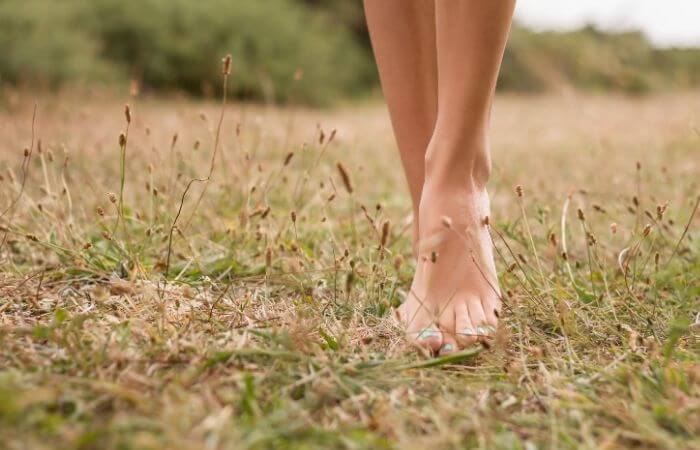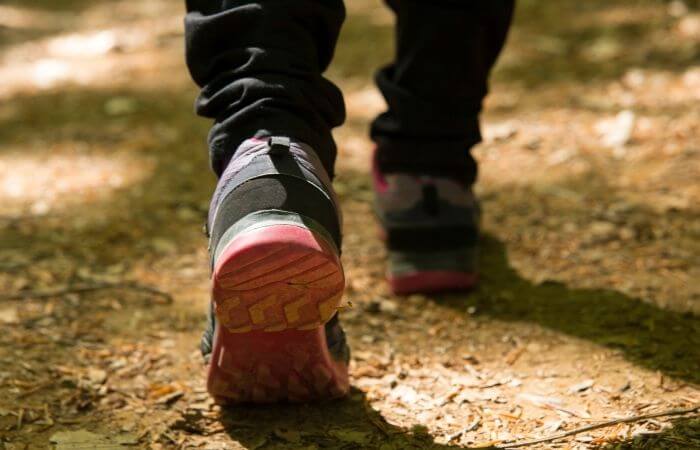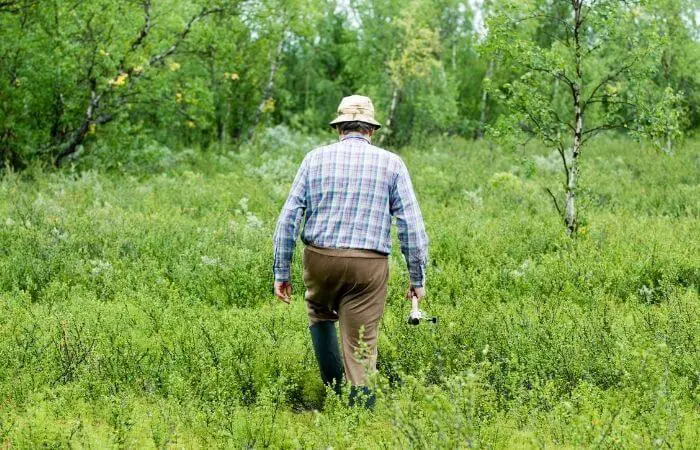Knowing how to walk quietly is a valuable skill that can come in useful in many different circumstances.
Whether you’re trying to sneak out of your sleeping child’s room, walk past wildlife, are hunting or you need to sneak away from a dangerous situation.

Whatever your reason is learning how to walk quietly is well worth your time.
Here are 7 things which will help you master the skill of silent walking:
1. Use The Right Footwear
To walk quietly you need to be wearing the right footwear.
Footwear that work well for quiet walking include:
- Barefoot
- Trainers
- Moccasins
- Any flexible, soft, light footwear
Footwear that is terrible for quiet walking includes:
- Boots
- Heels (obviously!)
- Any footwear with a stiff inflexible sole
- Any new shoe that is prone to being squeaky
For optimal quietness bare feet are the best option, this gives you the greatest control over what your feet are doing, it allows you to feel the surface of the floor before committing your full weight to a step and it also allows you to make use of the flexibility of your feet when walking.
That said walking in bare feet can also be the noisiest if you step on something sharp then the resulting cry of pain will be far noisier than the noise made by walking in boots.
If you’re outdoors then walking barefoot isn’t always an option, when outdoors you should opt for a soft training shoe which has thin flexible soles which allow you to feel the ground.

The very best shoes for this are Vibrams which are designed with super-thin flexible soles so that runners and climbers can experience the feeling of doing their sport barefoot while still protecting the feet.
If you are limited in choice and your only option is a squeaky pair of shoes then make sure you spend a bit of time learning how to make your shoes stop squeaking first.
2. Lower Your Centre Of Gravity
Crouching while walking helps to make your movement quieter for three reasons:
- It reduces the risk of stumbling or tripping over something – lowering your center of gravity means that you are more stable are therefore less likely to trip or fall over which will of course make a loud noise and blow your cover.
- It allows you to control the descent of your feet – bending your hips and legs allows you to slowly and carefully place your feet in a controlled manner. This reduces the risk of you placing your feet down heavily as you are more likely to do when stood fully upright.
- It slows you down – it’s hard to move as fast when you are crouched, moving more slowly will always make you quieter.

Of course one of the main benefits to crouching is that it makes you less visible and, if you’re concerned about walking quietly, then not being seen is probably important to you too.
3. How You Place Your Feet
The way you place your feet has the biggest impact on the amount of sound you make when walking.
If you slap your feet down in one solid movement a lot of air is immediately displaced and there is a greater risk that you will stand on something noisy with little way of controlling the amount of noise it makes.
Here are a couple of ways you can place your feet to help you walk quietly.
The Fox Walk
The fox walk is a method of quiet walking which is taught to the S.A.S and is commonly used by hunters to walk quietly in close proximity to their target.
To fox walk follow these steps:
- The outside of your foot close to your little toe is the first part of your foot that should make contact with the floor.
- Laterally roll your foot so that the inside of your foot near the big toe also makes contact with the floor.
- Then slowly bring your heel down so that all of your foot is touching the ground.
Fox walking is the quietest form of walking to use in pretty much all circumstances, especially in outdoor situations.
Tip Toeing
Tip Toeing is a method of walking that most of us are familar with.
Tip toeing can actually be quiet noisy if used in the wrong circumstances.
For example if you are walking on floorboards on your tip toes you create a concentrated area of pressure meaning the floorboard is more likely to creak and groan under your weight than if your weight is distributed across the entirety of your foot.

However if you are stepping between crunchy leaves then walking on your tiptoes is optimal as it minimizes the surface area in contact with the ground making it easier to avoid the crunchy leaves.
To tip-toe like a pro follow these steps:
- Keep your weight on your rear leg.
- Step forward with a bent leg and place your toes on the floor.
- Slowly increase the pressure applied through your toes.
- If you hear a slight noise such as a creak then withdraw your foot and try placing it in a different spot.
- If you hear no noise then keep applying pressure until you can transfer all of your weight onto your front foot.
Whatever silent walking method you choose the key is to do it slowly and carefully so that you can make adjustments as necessary if a step is likely to cause noise.
Also Read: How To Run Quietly
4. How You Transfer Weight With Each Step
Transferring weight carefully is key to ensuring that your walk is quiet.
You should have a low center of gravity already with a bend in your knees and a slight bend at your hips.
Transfer all of your weight onto one foot, then slowly step forward with the other foot, maintaining a bend in the knee.
If you do this with straight legs fully stood up it is much harder to control the descent of your foot so you will be far noisier.
Having a bend in your legs means that you are able to dampen the impact of your steps in a manner similar to the suspension in a car.
5. Watch Where You Place Your Feet
If you’re walking through a forest and step on a twig it is suprisingly audible.

The same is true if you’re trying to creep out of your child’s bedroom and you accidentally kick a toy.
When walking quietly keep your eyes focused on the floor, pay careful attention to any and every obstacle (no matter how small) as even treading on a small leaf can make significant noise.
Take care to avoid going near anything which may make serious noise. If you see a big pile of small twigs or autumnal leaves then walk around them rather than through them.
If you are walking around indoors then take care to avoid walking on hard uncovered surfaces such as a tiled or wooden floor as vibrations travel very easily through them.
Instead, where possible walk on parts of the floor that are carpeted or covered with a nice sound absorbing rug.
6. Be Aware Of Everything Around You
If you’re walking through a forest then making sure you are spatially aware is very important.
Make sure you know where the trees, bushes and shrubs are and avoid getting too close to them.

Just brushing lightly past a bush can make significant noise depending on the seasons (autumnal leaves tend to be the noisiest) and the fabrics you are wearing.
If you are trying to walk quietly through a room make sure you are aware of where furniture is, where items on the floor are and make sure to steer clear of them.
If possible keep your arms tucked in so that you don’t accidentally knock something.
7. Wear The Right Clothes
This is a minor point however wearing soft clothes can help you walk far more quietly.
Waterproof jackets or other stiff clothes have a tendency to rub and make swishing noises as you walk.
Wearing soft clothes made from cotton helps to eradicate fabric noise and prevents your clothing from giving you away.
8. Match Cadence
If you are trying to sneak up or sneak away from someone else who is also walking then matching their cadence is a good way of making your steps almost inaudible.
By matching their cadence your feet will strike the floor only when their feet do, the sound of their own footfall will cover the sound of your footfall allowing you to step without being heard.
9. Be Still
Knowing when to stop walking is an important skill to master.
If you are walking through a forest and the sound of your steps is masked by wind rustling the leaves then you can afford to be a bit less careful in the way you walk.
However if the wind suddenly drops or dies your sound cover is gone.
In this case it is a good idea to stop until the wind picks up again or the animal or person you are trying to walk quietly away from has moved on.
As an Amazon Associate I may earn a small fee from qualifying purchases at no extra cost to you. This helps us run the site, so thanks for your support!
